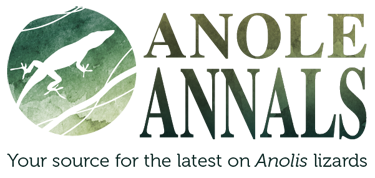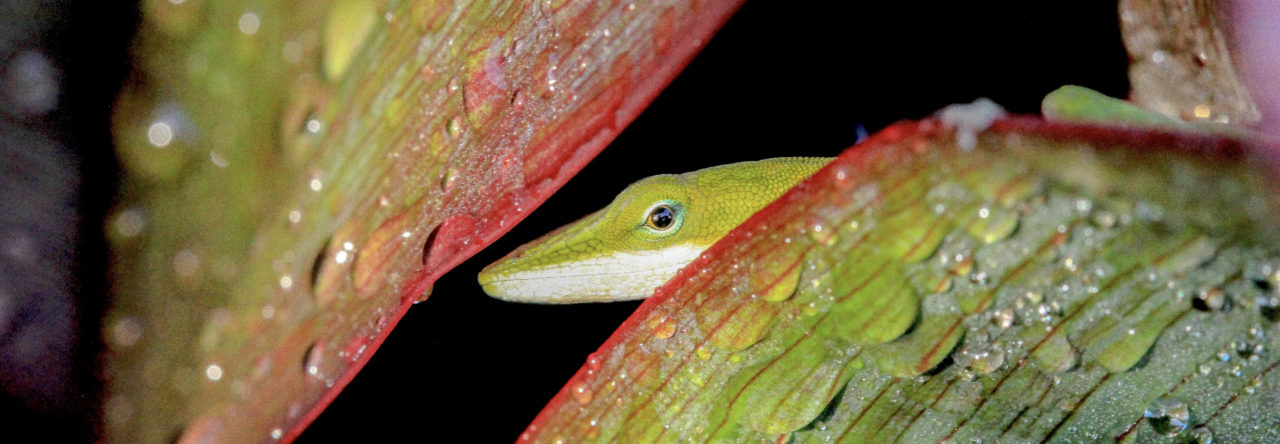
By Andres Marmol and Ignacio Moore
A new study by Diego R. Quirola and collaborators about the enigmatic Ecuadorian proboscis anole has been published a few weeks back. In this study, the authors report new ontogenic and social behaviour data regarding males of this amazing lizard and its most noticeable character: the proboscis. But before going into the data, lets draw a short background.
Of all the Ecuadorian reptiles, Anolis proboscis is arguably the most remarkable. Originally described by Peters and Orcés in 1956, this elusive species was not seen for almost 50 years and was believed to be extinct, until 2005 when a group of ornithologists spotted and photographed a male (see Almendáriz and Vogt, 2007; see this previous post for a discussion of this history). Since then, a number of researchers have been interested in this lizard. However, a major question remained unclear regarding the species’ most notable character: how do males use the fleshy rostral appendage in social interactions?
Ernest E. Williams (1979) gave the first reliable hypothesis around this question in his taxonomic analysis of the proboscis anoles (of which there are two additional species; see more details in Williams, 1979). Based on collected male specimens, he proposed that the proboscis was the result of sexual selection. Two main questions required an answer to support William’s hypothesis: (1) do females also have the proboscis (Females were unknown at that time)?; and (2) how is the proboscis used by these lizards (No data on the natural history of the species had been described particularly regarding social interactions).
The first part of the riddle was solved in 2010 when the females were discovered confirming that the proboscis was only observed in males (see Yánez-Muñoz et al., 2010 for a proper description). Documenting the behaviour of the species in nature, however, was a greater challenge —as anyone that has attempt to study animal behavior knows— due to both the cryptic coloration of the species and its elusive nature. Two more years went by before the first insights about the natural history of the species were known — Losos et al. (2012) described the habitat use, diet, and activity patterns, whereas Poe et al. (2012) reported anecdotal observations of intra- and intersexual social behavior of the species and some uses of the proboscis. Despite these advances, more detailed observations of the species’ social behavior were needed. And more importantly, the use of the proboscis remained undescribed.
This point is where the new publication becomes relevant. By using a semi-natural environment where males and females were placed, the authors were able to record social interactions for the first time in this species. In particular, the study describes the agonistic behaviour between males, including the displays and the proboscis function during the encounter. The study provides a complete description of the courtship and mating behavior, reporting for the first time a female display during male-female interactions. As a bonus, the research reports the ontogeny of the rostral appendage.
Among the highlights of the paper include the description of four different displays that the males appear to use. Most interesting is the behaviour termed “proboscis flourishing”: a display composed of stereotyped lateral movements of the head that appear to be a way to present the rostral appendage to the female counterpart. The authors discuss the possibility that females can be assessing males by using this display as it was only observed during male-female encounters and before chasing—another new report of the reproductive behaviour of the species—occur (Video 1, Supplementary material).

Journal of Natural History, 2017. doi:10.1080/00222933.2017.1332790
In addition, the paper reports the first captive-born A. proboscis along with a long-awaited answer: males are born with a tiny appendage (see a previous entry or check Hepu’s footage). But most of all, in terms of use of the rostral appendage, this study confirms with several independent observations that the proboscis is actively lifted before any bite attempt and is not, under any circumstance, used as a weapon against other males— as previously discussed by Poe et al. (2012) and Losos et al. (2012). In contrast, the authors suggest that the movement of the proboscis could be performed to facilitate feeding behaviors or even other behaviors related to courtship as the proboscis was lifted when males stimulate the female’s nape (similar to what is described in other anoles).
In the last ten years, knowledge about this enigmatic anole has increased substantially thanks to the contribution of studies like Quirola et al. In particular, is clear that the rostral appendage has no direct use in physical combat. However, there is still a long way to go before we understand why and how this exaggerated trait evolved. Other variables regarding proboscis morphology, such as size or straightness, could be possible characters that may be honest indicators of quality and/or may confer an advantage against other males during agonistic behaviors. One thing is sure: we have only scratched the surface of the mystery of the evolution of the proboscis and this fascinating lizard.
Useful References:
ALMENDÁRIZ, A. C. & VOGT, C. 2007. Anolis proboscis (SAURIA: POLYCHROTIDAE), UNA LAGARTIJA RARA PERO NO EXTINTA. Politécnica, 27, 157-9.
LOSOS, J. B., WOOLLEY, M. L., MAHLER, D. L., TORRES-CARVAJAL, O., CRANDELL, K. E., SCHAAD, E. W., NARVÁEZ, A. E., AYALA-VARELA, F. & HERREL, A. 2012. Notes on the Natural History of the Little-Known Ecuadorian Horned Anole, Anolis proboscis. Breviora, 1-17.
POE, S., AYALA, F., LATELLA, I. M., KENNEDY, T. L., CHRISTENSEN, J. A., GRAY, L. N., BLEA, N. J., ARMIJO, B. M. & SCHAAD, E. W. 2012. Morphology, Phylogeny, and Behavior of Anolis proboscis. Breviora, 1-11.
WILLIAMS, E. E. 1979. South American Anoles: The Species Groups. 2. The Proboscis Anoles (Anolis laevis Group). Breviora, 449, 1-19.
YÁNEZ-MUÑOZ, M., URGILÉS, M. A., ALTAMIRANO, M. B. & CÁCERES, S. S. R. 2010. Redrescripción de Anolis proboscis: Peters & Orcés (Reptilia: Polychrotidae), con el descubrimiento de las hembras de la especiey comentarios sobre su distribución y taxonomía. Avances en Ciencias e Ingeniería, 2, 1-14.
 Two years ago, McCranie and Kohler published The Anoles of Honduras: Systematics, Distribution, and Conservation(available on Amazon for under twenty bucks and downloadable for free on the Museum of Comparative Zoology website).
Two years ago, McCranie and Kohler published The Anoles of Honduras: Systematics, Distribution, and Conservation(available on Amazon for under twenty bucks and downloadable for free on the Museum of Comparative Zoology website).














